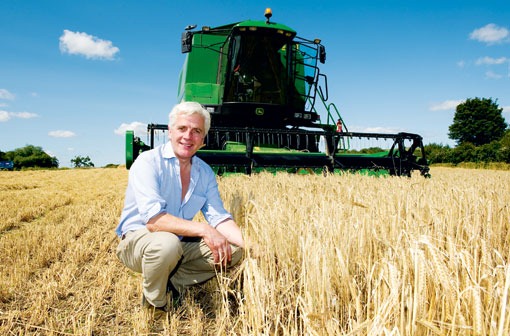Spring barley harvest started earlier than ever this year for Martin Hamilton after a prolonged spell of warm weather.
He started cutting his spring barley on Friday, 19 August – a week earlier than normal.
By Tuesday (23 August), 21.5ha of Westminster barley had been cut with yields averaging 5.7t/ha, coming off the combine between 18 and 20% moisture. The crop was sold to a local feed company and taken away to be dried.
"Spring barley harvest started extremely early this year – the earliest that I can remember," said Mr Hamilton.
"Northern Ireland just hasn’t been getting the rain that we normally would. However, crop quality is good and we are really pleased with the yields."
The barley straw was all baled with a McHale baler and sold off the field at £14 per bale to a livestock farmer.
Mr Hamilton was due to start cutting the remaining 45ha of spring barley, including Optic, this week.
Combinable crops contribute to a small part – around 8% – of annual turnover at Ballyrainey House, near Comber, County Down.
The main part of the business is Mash Direct, supplying mashed vegetable products directly to major supermarkets. Half of the produce is grown on farm with the rest being bought in.
"Business growth year-on-year is up 26% and this good harvest is giving us more reasons to feel optimistic," he said.
Potato harvest was also ahead of schedule and crops of Maris Piper were being desiccated seven to 10 days earlier than usual.
"That’s going to allow us to get a really good skin set, and at this rate, we will be storing potatoes by the third week of September at around 4C."
The first 4ha of carrots had been harvested, with an average yield of 37t/ha. But parsnips were slower than usual this year with just 2ha lifted, yielding 24t/ha.
Red and green cabbage, cauliflower and broccoli crops were showing "seriously good quality".
"We are very pleased with the quality of all these crops. It will really enhance our food processing business."
Jonathan Fenwick
The huge variability of crop yields on farm this harvest has stunned Humberside grower Jonathan Fenwick.
"Wheat yields have been the most variable I have ever seen in my life, ranging from 2.5t/ha to 12.3t/ha," he said.
"The light land farm has been a disaster and we have got some fairly poor crops. But on the heavier land crops are yielding better than we had expected, thanks largely to the rain we got in May."
Second wheats Duxford and Battalion have recorded respectable yields of around 10t/ha at Beelsby House Farm, near Grimsby. However, Cordiale yielded between 5t/ha and 10t/ha.
Mr Fenwick was blaming a lack of moisture during important periods of the growing season for the variability in yields.
"Crop establishment was good, they chucked tillers out, but some crops just gave up on this light Lincolnshire Wold land."
However, in hindsight, buying a new Opico Magna 38t dryer on farm for this season now felt like a Godsend after the late tillering, he admitted.
"Although the crops are dry there are so many green ears. We have got to get them through the dryer. It has been challenging, but another good week and we’ll nearly be done."
Mr Fenwick has started cutting first wheats for contract customers. But with rain forecast for this week, he expected progress to be slow.
First wheats on his own farm were now ripe and he was due to start cutting them this week, weather depending. "The first wheats on the good land will be good. We can’t wait to get going on them."
Spring barley had yielded exceptionally well, given the dry conditions, he said.
"We grew some Null-lox barley on a lager contract with Gleadell and we have got some excellent yields," he explained.
"On average it’s yielding just over 7.4t/ha, but as much as 8.9t/ha in places. The moisture content is between 13-14%, which is ideal."
Tipple spring barley is yielding around 1.65t/ha less than the Null-lox.
The winter oilseed rape harvest had finished and crops on light land crops had again struggled most, he said.
"Our best yields were from hybrid varieties Dimension and DK Sequoia, which was awesome. It yielded more than 6t/ha, which is a record yield on my farm."
As a result, 95% of the 2012 rape crop would consist of hybrids and the rest DK Cabernet, he added. "Around 60% has gone in the ground, all in good conditions."
http://www.fwi.co.uk/Articles/2011/08/24/128588/Spring-barley-shows-promise.htm?printerfriendly=true


Deprecated: strpos(): Passing null to parameter #1 ($haystack) of type string is deprecated in /home/agriviek8Qv/agriviet.net/public_html/wp-includes/comment-template.php on line 2522